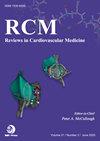脉搏波速度:方法、临床应用以及与心率变异性的相互作用
IF 1.9
4区 医学
Q3 CARDIAC & CARDIOVASCULAR SYSTEMS
引用次数: 0
摘要
脉搏波速度(PWV)已被确定为心血管诊断中一种有前途的生物标志物,可深入了解血管健康状况和心血管风险。脉搏波速度被定义为机械波沿动脉壁传播的速度,是动脉血管僵硬度的有效替代标志物。脉搏波速度已引起临床关注,尤其是在监测高血压和糖尿病等血管疾病患者时。脉搏波速度的作用还延伸到了预防性心脏病学领域,有助于识别和分层心血管风险。尽管开发了各种测量技术,如直接或间接眼压计、多普勒超声、振荡计分析和磁共振成像(MRI),但方法的多变性和缺乏标准化导致脉搏波速度评估不一致。此外,脉搏波速度还可以通过代用参数(如脉搏到达时间或脉搏通过时间)来估算,但这种异质性限制了其标准化,因此也限制了其临床应用。此外,交感神经张力的变化等混杂因素也会对脉搏波速度读数产生很大影响,因此在评估过程中必须小心控制。心率变异性(HRV)和脉搏波速度之间的双向关系强调了心脏自律神经功能和血管健康之间的相互作用,表明其中一个因素的改变会直接影响另一个因素。未来的研究应优先考虑脉搏波速度测量技术的标准化和可比性,并探索影响脉搏波速度的复杂生理变量。将脉搏波速度和心率变异等多种生理参数整合到基于人工智能的算法中,为推进个性化血管健康评估和心血管护理带来了巨大希望。本文章由计算机程序翻译,如有差异,请以英文原文为准。
Pulse Wave Velocity: Methodology, Clinical Applications, and Interplay with Heart Rate Variability
Pulse wave velocity (PWV) has been established as a promising biomarker in cardiovascular diagnostics, providing deep insights into vascular health and cardiovascular risk. Defined as the velocity at which the mechanical wave propagates along the arterial wall, PWV represents a useful surrogate marker for arterial vessel stiffness. PWV has garnered clinical attention, particularly in monitoring patients suffering from vascular diseases such as hypertension and diabetes mellitus. Its utility extends to preventive cardiology, aiding in identifying and stratifying cardiovascular risk. Despite the development of various measurement techniques, direct or indirect tonometry, Doppler ultrasound, oscillometric analysis, and magnetic resonance imaging (MRI), methodological variability and lack of standardization lead to inconsistencies in PWV assessment. In addition, PWV can be estimated through surrogate parameters, such as pulse arrival or pulse transit times, although this heterogeneity limits standardization and, therefore, its clinical use. Furthermore, confounding factors, such as variations in sympathetic tone, strongly influence PWV readings, thereby necessitating careful control during assessments. The bidirectional relationship between heart rate variability (HRV) and PWV underscores the interplay between cardiac autonomic function and vascular health, suggesting that alterations in one could directly influence the other. Future research should prioritize the standardization and increase comparability of PWV measurement techniques and explore the complex physiological variables influencing PWV. Integrating multiple physiological parameters such as PWV and HRV into algorithms based on artificial intelligence holds immense promise for advancing personalized vascular health assessments and cardiovascular care.
求助全文
通过发布文献求助,成功后即可免费获取论文全文。
去求助
来源期刊

Reviews in cardiovascular medicine
医学-心血管系统
CiteScore
2.70
自引率
3.70%
发文量
377
审稿时长
1 months
期刊介绍:
RCM is an international, peer-reviewed, open access journal. RCM publishes research articles, review papers and short communications on cardiovascular medicine as well as research on cardiovascular disease. We aim to provide a forum for publishing papers which explore the pathogenesis and promote the progression of cardiac and vascular diseases. We also seek to establish an interdisciplinary platform, focusing on translational issues, to facilitate the advancement of research, clinical treatment and diagnostic procedures. Heart surgery, cardiovascular imaging, risk factors and various clinical cardiac & vascular research will be considered.
 求助内容:
求助内容: 应助结果提醒方式:
应助结果提醒方式:


